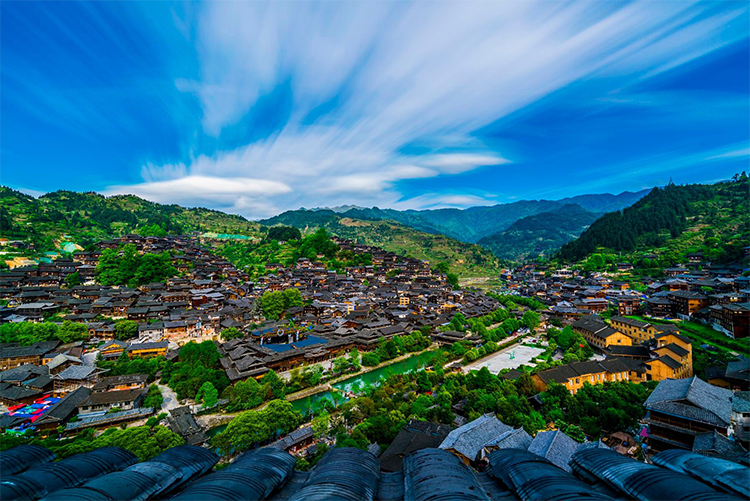Discover Xijiang Miao Village’s Stilt Houses: China’s Thousand-Household Wonder
Xijiang Miao Village: China’s Thousand-Household Wonder
When the first rays of dawn sweep over the Leigong Mountains, more than 1,200 brown wooden stilt houses wake like stepped terraces, their roofs melting into the morning mist. This is Xijiang Qianhu Miao Village — the largest living Miao community in the world, a ridge‑hanging “living museum” of ethnic culture. At night, when thousands of lights sprinkle the valley like stars, it’s easy to see why Lonely Planet called it “one of the planet’s most magical light festivals.”
1. Millennia‑old Terrace Architecture
The Miao ancestors of Xijiang practiced an age‑old way of living adapted to steep terrain: “no mountain uninhabited, no tree unused.” The village is the only place in China where a complete traditional Miao architectural ensemble and lifestyle survive. All wooden stilt houses (diaojiaolou) use mortise‑and‑tenon joinery with no nails; livestock are kept on the ground level, people live above, and the top storehouses hold grain. This elevated plan protects from damp and animals while fitting the mountainside. From the viewing platform, the rooftops cascade along the ridge like a giant piece of Miao embroidery — a sight that even visiting UNESCO assessors praised for its rare, gravity‑defying beauty.
2. Silver, Batik and the Living Miao Epic
Xijiang shines because its intangible cultural heritage is still alive. In Gage Old Alley, 75‑year‑old silversmith Master Wu still forges Miao silver the old way: melting ingots, hammering them into forms, and finishing massive “ox‑horn” headdresses that can weigh up to 20 jin. In nearby wax‑dye (batik) workshops, women use a copper knife dipped in melted wax to paint Mother Butterfly (a Miao creation myth) onto homespun cloth, then dye the fabric in indigo to create the village’s signature blue‑and‑white patterns. During the lunar October Miao New Year the whole village dresses in ceremonial attire for drum dances; every 13 years the Drum‑Storing Festival features ancestral sacrifices and raw, powerful rituals.

3. A Mountain Theatre of Seasons
Best months to visit:
September–November, when golden harvest terraces complement the stilt houses. Every season offers a distinct mood:
– Spring (Mar–May): misty mornings and peach blossoms give the village an ink‑and‑wash painting quality
– Summer (Jun–Aug): lush green valleys and pleasant nights averaging 23°C, a natural cooling system
– Winter (Dec–Feb): smoky hearths and cured meats fill the air with a hearty, festive atmosphere
For photographers, a post‑rain dawn on the viewing platform — when a sea of clouds flows through the stilt houses — is among China’s five most beautiful cloud‑sea scenes, according to China National Geographic. At night, standing on the covered bridge as thousands of lights come on feels like the Milky Way pouring into the valley.
4. Immersive Miao Life Experiences
Beyond sightseeing, travelers can dive deep into daily life:
– 2‑hour Miao embroidery workshop (materials included, about 120 RMB)
– Join a local hunter to collect mountain herbs and learn 30+ medicinal plants
– Stay in a stilt‑house homestay, share a hearth and hear ancient songs played on the lusheng (reed pipe)
– Take part in the mountain welcome ritual with 12 ox‑horn drinking cups
Families shouldn’t miss afternoon rice‑field fish catching; photographers should stake out the Dongyin village viewing platform at 4:00 AM to capture the “thousand households’ morning smoke.”

5. Practical Travel Guide
Getting there:
– From Guiyang: about 3 hours by car (highway + mountain road) or take the direct scenic shuttle (88 RMB/person; departures daily at 8:00 and 14:00)
– By high‑speed rail: alight at Kaili South, then transfer to a tourist bus (about 1 hour)
Tickets and opening hours:
– Standard ticket 110 RMB (includes shuttle within the site); night ticket 60 RMB (after 18:00)
– Advance reservation via the Xijiang Qianhu Miao Village WeChat official account is required (peak season daily cap ~30,000 visitors)
– Site open all day; indoor museums 9:00–17:30
Suggested stays:
– High‑end: Sanchunli·Meng Resort Hotel (pool facing the terraces)
– Character: Drum‑Storing Family Homestay (run by Miao royal descendants; offers ritual experiences)
– Budget: Butterfly Mother Hostel — near the old street
Food highlights:
Try the long‑table banquet’s sour soup fish (fermented with wild tomatoes and rice broth) and colorful glutinous rice served with local rice wine. Street snacks like freshly pounded glutinous rice cakes and black‑hair pig skewers are perfect late‑night treats.

6. Off‑the‑Beaten‑Path Ideas to Avoid Crowds
Peak crowds arrive during July–August and National Day. Smarter travelers:
– Stay midweek and shoot the empty alleys before 7:00 AM
– Explore less commercial satellite hamlets such as Yangpai Village and Yedong Village
– Attend the 5:00 AM “opening the village gate” ceremony — in winter you may catch ritual dances
“There are two places in the world where lights tell a civilization’s story: Tokyo Skytree and Xijiang’s thousand‑household Miao Village.” Walk beneath the stars on the covered bridge, run your hand along 400 years of mortise‑and‑tenon joints, and you’ll understand the Miao verse: “We wear our history, carve our myths on wood, and brew our ancestors’ stories into wine.” This is more than travel — it’s a cultural pilgrimage through time.


